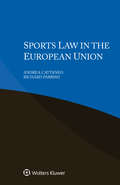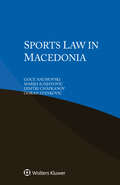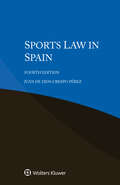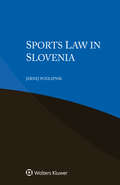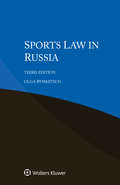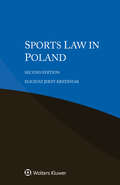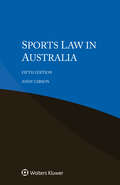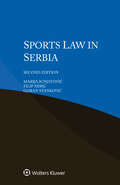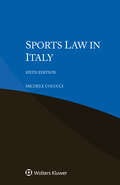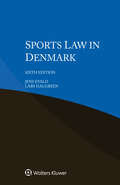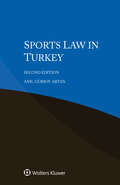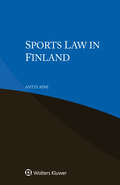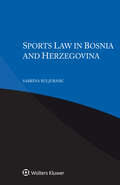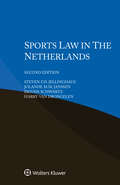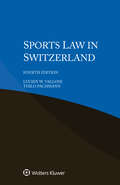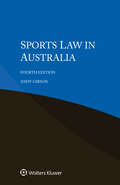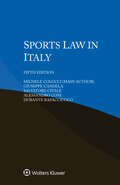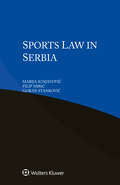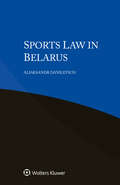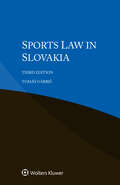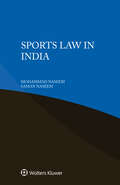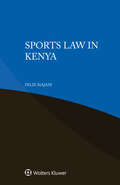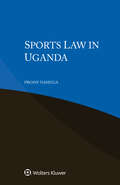- Table View
- List View
Sports Law in the European Union
by Andrea Cattaneo Richard ParrishDerived from the renowned multi-volume International Encyclopaedia of Laws, this practical analysis of sports law in the European Union deals with the regulation of sports activity by both public authorities and private sports organizations. The growing internationalization of sports inevitably increases the weight of global regulation, yet each country maintains its own distinct regime of sports law and its own national and local sports organizations. Sports law at a national or organizational level thus gains a growing relevance in comparative law. The book describes and discusses both state-created rules and autonomous self-regulation regarding the variety of economic, social, commercial, cultural, and political aspects of sports activities. Self- regulation manifests itself in the form of by-laws, and encompasses organizational provisions, disciplinary rules, and rules of play. However, the trend towards more professionalism in sports and the growing economic, social and cultural relevance of sports have prompted an increasing reliance on legal rules adopted by public authorities. This form of regulation appears in a variety of legal areas, including criminal law, labour law, commercial law, tax law, competition law, and tort law, and may vary following a particular type or sector of sport. It is in this dual and overlapping context that such much-publicized aspects as doping, sponsoring and media, and responsibility for injuries are legally measured. This monograph fills a gap in the legal literature by giving academics, practitioners, sports organizations, and policy makers access to sports law at this specific level. Lawyers representing parties with interests in the European Union will welcome this very useful guide, and academics and researchers will appreciate its value in the study of comparative sports law.
Sports Law in Macedonia
by Goce Naumovski Marija Ignjatović Dimtri Chapkanov Goran StankovićDerived from the renowned multi-volume International Encyclopaedia of Laws, this practical analysis of sports law in Macedonia deals with the regulation of sports activity by both public authorities and private sports organizations. The growing internationalization of sports inevitably increases the weight of global regulation, yet each country maintains its own distinct regime of sports law and its own national and local sports organizations. Sports law at a national or organizational level thus gains a growing relevance in comparative law. The book describes and discusses both state-created rules and autonomous self-regulation regarding the variety of economic, social, commercial, cultural, and political aspects of sports activities. Self- regulation manifests itself in the form of by-laws, and encompasses organizational provisions, disciplinary rules, and rules of play. However, the trend towards more professionalism in sports and the growing economic, social and cultural relevance of sports have prompted an increasing reliance on legal rules adopted by public authorities. This form of regulation appears in a variety of legal areas, including criminal law, labour law, commercial law, tax law, competition law, and tort law, and may vary following a particular type or sector of sport. It is in this dual and overlapping context that such much-publicized aspects as doping, sponsoring and media, and responsibility for injuries are legally measured. This monograph fills a gap in the legal literature by giving academics, practitioners, sports organizations, and policy makers access to sports law at this specific level. Lawyers representing parties with interests in Macedonia will welcome this very useful guide, and academics and researchers will appreciate its value in the study of comparative sports law.
Sports Law in Spain
by Juan de Dios Crespo PérezDerived from the renowned multi-volume International Encyclopaedia of Laws, this practical analysis of sports law in Spain deals with the regulation of sports activity by both public authorities and private sports organizations. The growing internationalization of sports inevitably increases the weight of global regulation, yet each country maintains its own distinct regime of sports law and its own national and local sports organizations. Sports law at a national or organizational level thus gains a growing relevance in comparative law. The book describes and discusses both state-created rules and autonomous self-regulation regarding the variety of economic, social, commercial, cultural, and political aspects of sports activities. Self- regulation manifests itself in the form of by-laws, and encompasses organizational provisions, disciplinary rules, and rules of play. However, the trend towards more professionalism in sports and the growing economic, social and cultural relevance of sports have prompted an increasing reliance on legal rules adopted by public authorities. This form of regulation appears in a variety of legal areas, including criminal law, labour law, commercial law, tax law, competition law, and tort law, and may vary following a particular type or sector of sport. It is in this dual and overlapping context that such much-publicized aspects as doping, sponsoring and media, and responsibility for injuries are legally measured. This monograph fills a gap in the legal literature by giving academics, practitioners, sports organizations, and policy makers access to sports law at this specific level. Lawyers representing parties with interests in Spain will welcome this very useful guide, and academics and researchers will appreciate its value in the study of comparative sports law.
Sports Law in Slovenia
by Jernej PodlipnikDerived from the renowned multi-volume International Encyclopaedia of Laws, this practical analysis of sports law in Slovenia deals with the regulation of sports activity by both public authorities and private sports organizations. The growing internationalization of sports inevitably increases the weight of global regulation, yet each country maintains its own distinct regime of sports law and its own national and local sports organizations. Sports law at a national or organizational level thus gains a growing relevance in comparative law. The book describes and discusses both state-created rules and autonomous self-regulation regarding the variety of economic, social, commercial, cultural, and political aspects of sports activities. Self- regulation manifests itself in the form of by-laws, and encompasses organizational provisions, disciplinary rules, and rules of play. However, the trend towards more professionalism in sports and the growing economic, social and cultural relevance of sports have prompted an increasing reliance on legal rules adopted by public authorities. This form of regulation appears in a variety of legal areas, including criminal law, labour law, commercial law, tax law, competition law, and tort law, and may vary following a particular type or sector of sport. It is in this dual and overlapping context that such much-publicized aspects as doping, sponsoring and media, and responsibility for injuries are legally measured. This monograph fills a gap in the legal literature by giving academics, practitioners, sports organizations, and policy makers access to sports law at this specific level. Lawyers representing parties with interests in Slovenia will welcome this very useful guide, and academics and researchers will appreciate its value in the study of comparative sports law.
Sports Law in Russia (3)
by Olga RymkevichDerived from the renowned multi-volume International Encyclopaedia of Laws, this practical analysis of sports law in Russia deals with the regulation of sports activity by both public authorities and private sports organizations. The growing internationalization of sports inevitably increases the weight of global regulation, yet each country maintains its own distinct regime of sports law and its own national and local sports organizations. Sports law at a national or organizational level thus gains a growing relevance in comparative law. The book describes and discusses both state-created rules and autonomous self-regulation regarding the variety of economic, social, commercial, cultural, and political aspects of sports activities. Self- regulation manifests itself in the form of by-laws, and encompasses organizational provisions, disciplinary rules, and rules of play. However, the trend towards more professionalism in sports and the growing economic, social and cultural relevance of sports have prompted an increasing reliance on legal rules adopted by public authorities. This form of regulation appears in a variety of legal areas, including criminal law, labour law, commercial law, tax law, competition law, and tort law, and may vary following a particular type or sector of sport. It is in this dual and overlapping context that such much-publicized aspects as doping, sponsoring and media, and responsibility for injuries are legally measured. This monograph fills a gap in the legal literature by giving academics, practitioners, sports organizations, and policy makers access to sports law at this specific level. Lawyers representing parties with interests in Russia will welcome this very useful guide, and academics and researchers will appreciate its value in the study of comparative sports law.
Sports Law in Poland
by Eligiusz Jerzy KrześniakDerived from the renowned multi-volume International Encyclopaedia of Laws, this practical analysis of sports law in Poland deals with the regulation of sports activity by both public authorities and private sports organizations. The growing internationalization of sports inevitably increases the weight of global regulation, yet each country maintains its own distinct regime of sports law and its own national and local sports organizations. Sports law at a national or organizational level thus gains a growing relevance in comparative law. The book describes and discusses both state-created rules and autonomous self-regulation regarding the variety of economic, social, commercial, cultural, and political aspects of sports activities. Self- regulation manifests itself in the form of by-laws, and encompasses organizational provisions, disciplinary rules, and rules of play. However, the trend towards more professionalism in sports and the growing economic, social and cultural relevance of sports have prompted an increasing reliance on legal rules adopted by public authorities. This form of regulation appears in a variety of legal areas, including criminal law, labour law, commercial law, tax law, competition law, and tort law, and may vary following a particular type or sector of sport. It is in this dual and overlapping context that such much-publicized aspects as doping, sponsoring and media, and responsibility for injuries are legally measured. This monograph fills a gap in the legal literature by giving academics, practitioners, sports organizations, and policy makers access to sports law at this specific level. Lawyers representing parties with interests in Poland will welcome this very useful guide, and academics and researchers will appreciate its value in the study of comparative sports law.
Sports Law in Australia
by Andy GibsonDerived from the renowned multi-volume International Encyclopaedia of Laws, this practical analysis of sports law in Australia deals with the regulation of sports activity by both public authorities and private sports organizations. The growing internationalization of sports inevitably increases the weight of global regulation, yet each country maintains its own distinct regime of sports law and its own national and local sports organizations. Sports law at a national or organizational level thus gains a growing relevance in comparative law. The book describes and discusses both state-created rules and autonomous self-regulation regarding the variety of economic, social, commercial, cultural, and political aspects of sports activities. Self- regulation manifests itself in the form of by-laws, and encompasses organizational provisions, disciplinary rules, and rules of play. However, the trend towards more professionalism in sports and the growing economic, social and cultural relevance of sports have prompted an increasing reliance on legal rules adopted by public authorities. This form of regulation appears in a variety of legal areas, including criminal law, labour law, commercial law, tax law, competition law, and tort law, and may vary following a particular type or sector of sport. It is in this dual and overlapping context that such much-publicized aspects as doping, sponsoring and media, and responsibility for injuries are legally measured. This monograph fills a gap in the legal literature by giving academics, practitioners, sports organizations, and policy makers access to sports law at this specific level. Lawyers representing parties with interests in Australia will welcome this very useful guide, and academics and researchers will appreciate its value in the study of comparative sports law.
Sports Law in Serbia
by Marija Ignjatović Filip Mirić Goran StankovićDerived from the renowned multi-volume International Encyclopaedia of Laws, this practical analysis of sports law in Serbia deals with the regulation of sports activity by both public authorities and private sports organizations. The growing internationalization of sports inevitably increases the weight of global regulation, yet each country maintains its own distinct regime of sports law and its own national and local sports organizations. Sports law at a national or organizational level thus gains a growing relevance in comparative law. The book describes and discusses both state-created rules and autonomous self-regulation regarding the variety of economic, social, commercial, cultural, and political aspects of sports activities. Self- regulation manifests itself in the form of by-laws, and encompasses organizational provisions, disciplinary rules, and rules of play. However, the trend towards more professionalism in sports and the growing economic, social and cultural relevance of sports have prompted an increasing reliance on legal rules adopted by public authorities. This form of regulation appears in a variety of legal areas, including criminal law, labour law, commercial law, tax law, competition law, and tort law, and may vary following a particular type or sector of sport. It is in this dual and overlapping context that such much-publicized aspects as doping, sponsoring and media, and responsibility for injuries are legally measured. This monograph fills a gap in the legal literature by giving academics, practitioners, sports organizations, and policy makers access to sports law at this specific level. Lawyers representing parties with interests in Serbia will welcome this very useful guide, and academics and researchers will appreciate its value in the study of comparative sports law.
Sports Law in Italy
by Michele ColucciDerived from the renowned multi-volume International Encyclopaedia of Laws, this practical analysis of sports law in Italy deals with the regulation of sports activity by both public authorities and private sports organizations. The growing internationalization of sports inevitably increases the weight of global regulation, yet each country maintains its own distinct regime of sports law and its own national and local sports organizations. Sports law at a national or organizational level thus gains a growing relevance in comparative law. The book describes and discusses both state-created rules and autonomous self-regulation regarding the variety of economic, social, commercial, cultural, and political aspects of sports activities. Self- regulation manifests itself in the form of by-laws, and encompasses organizational provisions, disciplinary rules, and rules of play. However, the trend towards more professionalism in sports and the growing economic, social and cultural relevance of sports have prompted an increasing reliance on legal rules adopted by public authorities. This form of regulation appears in a variety of legal areas, including criminal law, labour law, commercial law, tax law, competition law, and tort law, and may vary following a particular type or sector of sport. It is in this dual and overlapping context that such much-publicized aspects as doping, sponsoring and media, and responsibility for injuries are legally measured. This monograph fills a gap in the legal literature by giving academics, practitioners, sports organizations, and policy makers access to sports law at this specific level. Lawyers representing parties with interests in Italy will welcome this very useful guide, and academics and researchers will appreciate its value in the study of comparative sports law.
Sports Law in Denmark
by Jens Evald Lars HalgreenDerived from the renowned multi-volume International Encyclopaedia of Laws, this practical analysis of sports law in Denmark deals with the regulation of sports activity by both public authorities and private sports organizations. The growing internationalization of sports inevitably increases the weight of global regulation, yet each country maintains its own distinct regime of sports law and its own national and local sports organizations. Sports law at a national or organizational level thus gains a growing relevance in comparative law. The book describes and discusses both state-created rules and autonomous self-regulation regarding the variety of economic, social, commercial, cultural, and political aspects of sports activities. Self-regulation manifests itself in the form of by-laws, and encompasses organizational provisions, disciplinary rules, and rules of play. However, the trend towards more professionalism in sports and the growing economic, social and cultural relevance of sports have prompted an increasing reliance on legal rules adopted by public authorities. This form of regulation appears in a variety of legal areas, including criminal law, labour law, commercial law, tax law, competition law, and tort law, and may vary following a particular type or sector of sport. It is in this dual and overlapping context that such much-publicized aspects as doping, sponsoring and media, and responsibility for injuries are legally measured. This monograph fills a gap in the legal literature by giving academics, practitioners, sports organizations, and policy makers access to sports law at this specific level. Lawyers representing parties with interests in Denmark will welcome this very useful guide, and academics and researchers will appreciate its value in the study of comparative sports law.
Sports Law in Turkey
by Anıl Gürsoy ArtanDerived from the renowned multi-volume International Encyclopaedia of Laws, this practical analysis of sports law in Turkey deals with the regulation of sports activity by both public authorities and private sports organizations. The growing internationalization of sports inevitably increases the weight of global regulation, yet each country maintains its own distinct regime of sports law and its own national and local sports organizations. Sports law at a national or organizational level thus gains a growing relevance in comparative law. The book describes and discusses both state-created rules and autonomous self-regulation regarding the variety of economic, social, commercial, cultural, and political aspects of sports activities. Self- regulation manifests itself in the form of by-laws, and encompasses organizational provisions, disciplinary rules, and rules of play. However, the trend towards more professionalism in sports and the growing economic, social and cultural relevance of sports have prompted an increasing reliance on legal rules adopted by public authorities. This form of regulation appears in a variety of legal areas, including criminal law, labour law, commercial law, tax law, competition law, and tort law, and may vary following a particular type or sector of sport. It is in this dual and overlapping context that such much-publicized aspects as doping, sponsoring and media, and responsibility for injuries are legally measured. This monograph fills a gap in the legal literature by giving academics, practitioners, sports organizations, and policy makers access to sports law at this specific level. Lawyers representing parties with interests in Turkey will welcome this very useful guide, and academics and researchers will appreciate its value in the study of comparative sports law.
Sports Law in Finland
by Antti AineDerived from the renowned multi-volume International Encyclopaedia of Laws, this practical analysis of sports law in Finland deals with the regulation of sports activity by both public authorities and private sports organizations. The growing internationalization of sports inevitably increases the weight of global regulation, yet each country maintains its own distinct regime of sports law and its own national and local sports organizations. Sports law at a national or organizational level thus gains a growing relevance in comparative law. The book describes and discusses both state-created rules and autonomous self-regulation regarding the variety of economic, social, commercial, cultural, and political aspects of sports activities. Self- regulation manifests itself in the form of by-laws, and encompasses organizational provisions, disciplinary rules, and rules of play. However, the trend towards more professionalism in sports and the growing economic, social and cultural relevance of sports have prompted an increasing reliance on legal rules adopted by public authorities. This form of regulation appears in a variety of legal areas, including criminal law, labour law, commercial law, tax law, competition law, and tort law, and may vary following a particular type or sector of sport. It is in this dual and overlapping context that such much-publicized aspects as doping, sponsoring and media, and responsibility for injuries are legally measured. This monograph fills a gap in the legal literature by giving academics, practitioners, sports organizations, and policy makers access to sports law at this specific level. Lawyers representing parties with interests in Finland will welcome this very useful guide, and academics and researchers will appreciate its value in the study of comparative sports law.
Sports Law in Bosnia and Herzegovina
by Sabrina BuljubasicDerived from the renowned multi-volume International Encyclopaedia of Laws, this practical analysis of sports law in Bosnia and Herzegovina deals with the regulation of sports activity by both public authorities and private sports organizations. The growing internationalization of sports inevitably increases the weight of global regulation, yet each country maintains its own distinct regime of sports law and its own national and local sports organizations. Sports law at a national or organizational level thus gains a growing relevance in comparative law. The book describes and discusses both state-created rules and autonomous self-regulation regarding the variety of economic, social, commercial, cultural, and political aspects of sports activities. Self- regulation manifests itself in the form of by-laws, and encompasses organizational provisions, disciplinary rules, and rules of play. However, the trend towards more professionalism in sports and the growing economic, social and cultural relevance of sports have prompted an increasing reliance on legal rules adopted by public authorities. This form of regulation appears in a variety of legal areas, including criminal law, labour law, commercial law, tax law, competition law, and tort law, and may vary following a particular type or sector of sport. It is in this dual and overlapping context that such much-publicized aspects as doping, sponsoring and media, and responsibility for injuries are legally measured. This monograph fills a gap in the legal literature by giving academics, practitioners, sports organizations, and policy makers access to sports law at this specific level. Lawyers representing parties with interests in Bosnia and Herzegovina will welcome this very useful guide, and academics and researchers will appreciate its value in the study of comparative sports law.
Sports Law in The Netherlands
by Steven F.H. Jellinghaus Jolande M.M. Janssen Dennis Schwartz Harry Van Drongelen<span style="mso-fareast-font-family:""; mso-bidi-font-family:"Times New Roman";mso-ansi-language:EN-GB">Derived from the renowned multi-volume <span style="mso-fareast-font-family:""; mso-bidi-font-family:"Times New Roman";mso-ansi-language:EN-GB">International Encyclopaedia of Laws<span style="mso-fareast-font-family:""; mso-bidi-font-family:"Times New Roman";mso-ansi-language:EN-GB">, this practical analysis of sports law in The Netherlands deals with the regulation of sports activity by both public authorities and private sports organizations. The growing internationalization of sports inevitably increases the weight of global regulation, yet each country maintains its own distinct regime of sports law and its own national and local sports organizations. Sports law at a national or organizational level thus gains a growing relevance in comparative law. <span style="mso-fareast-font-family:"";mso-bidi-font-family:"Times New Roman"; mso-ansi-language:EN-GB">The book describes and discusses both state-created rules and autonomous self-regulation regarding the variety of economic, social, commercial, cultural, and political aspects of sports activities. Self- regulation manifests itself in the form of by-laws, and encompasses organizational provisions, disciplinary rules, and rules of play. However, the trend towards more professionalism in sports and the growing economic, social and cultural relevance of sports have prompted an increasing reliance on legal rules adopted by public authorities. This form of regulation appears in a variety of legal areas, including criminal law, labour law, commercial law, tax law, competition law, and tort law, and may vary following a particular type or sector of sport. It is in this dual and overlapping context that such much-publicized aspects as doping, sponsoring and media, and responsibility for injuries are legally measured. <span style="font-size:12.0pt;font-family:"Times New Roman",serif; mso-fareast-font-family:"";mso-font-kerning:.5pt;mso-ansi-language:EN-GB; mso-fareast-language:HI;mso-bidi-language:HI">This monograph fills a gap in the legal literature by giving academics, practitioners, sports organizations, and policy makers access to sports law at this specific level. Lawyers representing parties with interests in The Netherlands will welcome this very useful guide, and academics and researchers will appreciate its value in the study of comparative sports law.
Sports Law in Switzerland
by Lucien W. Valloni Thilo Pachmann<span style="mso-fareast-font-family:"";mso-bidi-font-family:"Times New Roman"; mso-ansi-language:EN-GB">Derived from the renowned multi-volume <span style="mso-fareast-font-family:"";mso-bidi-font-family:"Times New Roman"; mso-ansi-language:EN-GB">International Encyclopaedia of Laws<span style="mso-fareast-font-family:"";mso-bidi-font-family:"Times New Roman"; mso-ansi-language:EN-GB">, this practical analysis of sports law in Switzerland deals with the regulation of sports activity by both public authorities and private sports organizations. The growing internationalization of sports inevitably increases the weight of global regulation, yet each country maintains its own distinct regime of sports law and its own national and local sports organizations. Sports law at a national or organizational level thus gains a growing relevance in comparative law. <span style="mso-fareast-font-family:"";mso-bidi-font-family:"Times New Roman"; mso-ansi-language:EN-GB">The book describes and discusses both state-created rules and autonomous self-regulation regarding the variety of economic, social, commercial, cultural, and political aspects of sports activities. Self- regulation manifests itself in the form of by-laws, and encompasses organizational provisions, disciplinary rules, and rules of play. However, the trend towards more professionalism in sports and the growing economic, social and cultural relevance of sports have prompted an increasing reliance on legal rules adopted by public authorities. This form of regulation appears in a variety of legal areas, including criminal law, labour law, commercial law, tax law, competition law, and tort law, and may vary following a particular type or sector of sport. It is in this dual and overlapping context that such much-publicized aspects as doping, sponsoring and media, and responsibility for injuries are legally measured. <span style="font-size:12.0pt;font-family:"Times New Roman",serif; mso-fareast-font-family:"";mso-font-kerning:.5pt;mso-ansi-language:EN-GB; mso-fareast-language:HI;mso-bidi-language:HI">This monograph fills a gap in the legal literature by giving academics, practitioners, sports organizations, and policy makers access to sports law at this specific level. Lawyers representing parties with interests in Switzerland will welcome this very useful guide, and academics and researchers will appreciate its value in the study of comparative sports law.
Sports Law in Australia
by Andy Gibson<span style="mso-fareast-font-family:""; mso-bidi-font-family:"Times New Roman";mso-ansi-language:EN-GB">Derived from the renowned multi-volume <span style="mso-fareast-font-family:""; mso-bidi-font-family:"Times New Roman";mso-ansi-language:EN-GB">International Encyclopaedia of Laws<span style="mso-fareast-font-family:""; mso-bidi-font-family:"Times New Roman";mso-ansi-language:EN-GB">, this practical analysis of sports law in Australia deals with the regulation of sports activity by both public authorities and private sports organizations. The growing internationalization of sports inevitably increases the weight of global regulation, yet each country maintains its own distinct regime of sports law and its own national and local sports organizations. Sports law at a national or organizational level thus gains a growing relevance in comparative law. <span style="mso-fareast-font-family:"";mso-bidi-font-family:"Times New Roman"; mso-ansi-language:EN-GB">The book describes and discusses both state-created rules and autonomous self-regulation regarding the variety of economic, social, commercial, cultural, and political aspects of sports activities. Self- regulation manifests itself in the form of by-laws, and encompasses organizational provisions, disciplinary rules, and rules of play. However, the trend towards more professionalism in sports and the growing economic, social and cultural relevance of sports have prompted an increasing reliance on legal rules adopted by public authorities. This form of regulation appears in a variety of legal areas, including criminal law, labour law, commercial law, tax law, competition law, and tort law, and may vary following a particular type or sector of sport. It is in this dual and overlapping context that such much-publicized aspects as doping, sponsoring and media, and responsibility for injuries are legally measured. <span style="mso-fareast-font-family:"";mso-bidi-font-family:"Times New Roman"; mso-ansi-language:EN-GB">This monograph fills a gap in the legal literature by giving academics, practitioners, sports organizations, and policy makers access to sports law at this specific level. Lawyers representing parties with interests in Australia will welcome this very useful guide, and academics and researchers will appreciate its value in the study of comparative sports law.
Sports Law in Italy
by Michele Colucci Giuseppe Candela Salvatore Civale Alessandro Coni Durante Rapacciuolo<span style="mso-fareast-font-family:""; mso-bidi-font-family:"Times New Roman";mso-ansi-language:EN-GB">Derived from the renowned multi-volume International Encyclopaedia of Laws, this practical analysis of sports law in Italy deals with the regulation of sports activity by both public authorities and private sports organizations. The growing internationalization of sports inevitably increases the weight of global regulation, yet each country maintains its own distinct regime of sports law and its own national and local sports organizations. Sports law at a national or organizational level thus gains a growing relevance in comparative law. <span style="mso-fareast-font-family:"";mso-bidi-font-family:"Times New Roman"; mso-ansi-language:EN-GB">The book describes and discusses both state-created rules and autonomous self-regulation regarding the variety of economic, social, commercial, cultural, and political aspects of sports activities. Self-regulation manifests itself in the form of by-laws, and encompasses organizational provisions, disciplinary rules, and rules of play. However, the trend towards more professionalism in sports and the growing economic, social and cultural relevance of sports have prompted an increasing reliance on legal rules adopted by public authorities. This form of regulation appears in a variety of legal areas, including criminal law, labour law, commercial law, tax law, competition law, and tort law, and may vary following a particular type or sector of sport. It is in this dual and overlapping context that such much-publicized aspects as doping, sponsoring and media, and responsibility for injuries are legally measured. <span style="font-size:12.0pt;font-family:"Times New Roman",serif; mso-fareast-font-family:"";mso-font-kerning:.5pt;mso-ansi-language:EN-GB; mso-fareast-language:HI;mso-bidi-language:HI">This monograph fills a gap in the legal literature by giving academics, practitioners, sports organizations, and policy makers access to sports law at this specific level. Lawyers representing parties with interests in Italy will welcome this very useful guide, and academics and researchers will appreciate its value in the study of comparative sports law.
Sports Law in Japan
by Takuya Yamazaki<span style="mso-fareast-font-family:"";mso-bidi-font-family:"Times New Roman"; mso-ansi-language:EN-GB">Derived from the renowned multi-volume <span style="mso-fareast-font-family:"";mso-bidi-font-family:"Times New Roman"; mso-ansi-language:EN-GB">International Encyclopaedia of Laws,<span style="mso-fareast-font-family:"";mso-bidi-font-family:"Times New Roman"; mso-ansi-language:EN-GB"> this practical analysis of sports law in Japan deals with the regulation of sports activity by both public authorities and private sports organizations. The growing internationalization of sports inevitably increases the weight of global regulation, yet each country maintains its own distinct regime of sports law and its own national and local sports organizations. Sports law at a national or organizational level thus gains a growing relevance in comparative law. <span style="mso-fareast-font-family:"";mso-bidi-font-family:"Times New Roman"; mso-ansi-language:EN-GB">The book describes and discusses both state-created rules and autonomous self-regulation regarding the variety of economic, social, commercial, cultural, and political aspects of sports activities. Self-regulation manifests itself in the form of by-laws, and encompasses organizational provisions, disciplinary rules, and rules of play. However, the trend towards more professionalism in sports and the growing economic, social and cultural relevance of sports have prompted an increasing reliance on legal rules adopted by public authorities. This form of regulation appears in a variety of legal areas, including criminal law, labour law, commercial law, tax law, competition law, and tort law, and may vary following a particular type or sector of sport. It is in this dual and overlapping context that such much-publicized aspects as doping, sponsoring and media, and responsibility for injuries are legally measured. <span style="font-size:12.0pt;font-family:"Times New Roman",serif; mso-fareast-font-family:"";mso-font-kerning:.5pt;mso-ansi-language:EN-GB; mso-fareast-language:HI;mso-bidi-language:HI">This monograph fills a gap in the legal literature by giving academics, practitioners, sports organizations, and policy makers access to sports law at this specific level. Lawyers representing parties with interests in Japan will welcome this very useful guide, and academics and researchers will appreciate its value in the study of comparative sports law.
Sports Law in Serbia
by Marija Ignjatović Filip Mirić Goran Stanković<span style="mso-fareast-font-family:"";mso-bidi-font-family:"Times New Roman"; mso-ansi-language:EN-GB">Derived from the renowned multi-volume <span style="mso-fareast-font-family:"";mso-bidi-font-family:"Times New Roman"; mso-ansi-language:EN-GB">International Encyclopaedia of Laws<span style="mso-fareast-font-family:"";mso-bidi-font-family:"Times New Roman"; mso-ansi-language:EN-GB">, this practical analysis of sports law in Serbia deals with the regulation of sports activity by both public authorities and private sports organizations. The growing internationalization of sports inevitably increases the weight of global regulation, yet each country maintains its own distinct regime of sports law and its own national and local sports organizations. Sports law at a national or organizational level thus gains a growing relevance in comparative law. <span style="mso-fareast-font-family:"";mso-bidi-font-family:"Times New Roman"; mso-ansi-language:EN-GB">The book describes and discusses both state-created rules and autonomous self-regulation regarding the variety of economic, social, commercial, cultural, and political aspects of sports activities. Self- regulation manifests itself in the form of by-laws, and encompasses organizational provisions, disciplinary rules, and rules of play. However, the trend towards more professionalism in sports and the growing economic, social and cultural relevance of sports have prompted an increasing reliance on legal rules adopted by public authorities. This form of regulation appears in a variety of legal areas, including criminal law, labour law, commercial law, tax law, competition law, and tort law, and may vary following a particular type or sector of sport. It is in this dual and overlapping context that such much-publicized aspects as doping, sponsoring and media, and responsibility for injuries are legally measured. <span style="font-size:12.0pt;font-family:"Times New Roman",serif; mso-fareast-font-family:"";mso-font-kerning:.5pt;mso-ansi-language:EN-GB; mso-fareast-language:HI;mso-bidi-language:HI">This monograph fills a gap in the legal literature by giving academics, practitioners, sports organizations, and policy makers access to sports law at this specific level. Lawyers representing parties with interests in Serbia will welcome this very useful guide, and academics and researchers will appreciate its value in the study of comparative sports law.
Sports Law in Belarus
by Aliaksandr Danilevich<span style="mso-fareast-font-family:"";mso-bidi-font-family:"Times New Roman"; mso-ansi-language:EN-GB">Derived from the renowned multi-volume <span style="mso-fareast-font-family:"";mso-bidi-font-family:"Times New Roman"; mso-ansi-language:EN-GB">International Encyclopaedia of Laws<span style="mso-fareast-font-family:"";mso-bidi-font-family:"Times New Roman"; mso-ansi-language:EN-GB">, this practical analysis of sports law in Belarus deals with the regulation of sports activity by both public authorities and private sports organizations. The growing internationalization of sports inevitably increases the weight of global regulation, yet each country maintains its own distinct regime of sports law and its own national and local sports organizations. Sports law at a national or organizational level thus gains a growing relevance in comparative law. <span style="mso-fareast-font-family:"";mso-bidi-font-family:"Times New Roman"; mso-ansi-language:EN-GB">The book describes and discusses both state-created rules and autonomous self-regulation regarding the variety of economic, social, commercial, cultural, and political aspects of sports activities. Self- regulation manifests itself in the form of by-laws, and encompasses organizational provisions, disciplinary rules, and rules of play. However, the trend towards more professionalism in sports and the growing economic, social and cultural relevance of sports have prompted an increasing reliance on legal rules adopted by public authorities. This form of regulation appears in a variety of legal areas, including criminal law, labour law, commercial law, tax law, competition law, and tort law, and may vary following a particular type or sector of sport. It is in this dual and overlapping context that such much-publicized aspects as doping, sponsoring and media, and responsibility for injuries are legally measured. <span style="font-size:12.0pt;font-family:"Times New Roman",serif; mso-fareast-font-family:"";mso-font-kerning:.5pt;mso-ansi-language:EN-GB; mso-fareast-language:HI;mso-bidi-language:HI">This monograph fills a gap in the legal literature by giving academics, practitioners, sports organizations, and policy makers access to sports law at this specific level. Lawyers representing parties with interests in Belarus will welcome this very useful guide, and academics and researchers will appreciate its value in the study of comparative sports law.
Sports Law in Slovakia
by Tomáš Gábriš<span style="mso-fareast-font-family:"";mso-bidi-font-family:"Times New Roman"; mso-ansi-language:EN-GB">Derived from the renowned multi-volume <span style="mso-fareast-font-family:"";mso-bidi-font-family:"Times New Roman"; mso-ansi-language:EN-GB">International Encyclopaedia of Laws<span style="mso-fareast-font-family:"";mso-bidi-font-family:"Times New Roman"; mso-ansi-language:EN-GB">, this practical analysis of sports law in Slovakia deals with the regulation of sports activity by both public authorities and private sports organizations. The growing internationalization of sports inevitably increases the weight of global regulation, yet each country maintains its own distinct regime of sports law and its own national and local sports organizations. Sports law at a national or organizational level thus gains a growing relevance in comparative law. <span style="mso-fareast-font-family:"";mso-bidi-font-family:"Times New Roman"; mso-ansi-language:EN-GB"> <span style="mso-fareast-font-family:"";mso-bidi-font-family:"Times New Roman"; mso-ansi-language:EN-GB">The book describes and discusses both state-created rules and autonomous self-regulation regarding the variety of economic, social, commercial, cultural, and political aspects of sports activities. Self-regulation manifests itself in the form of by-laws, and encompasses organizational provisions, disciplinary rules, and rules of play. However, the trend towards more professionalism in sports and the growing economic, social and cultural relevance of sports have prompted an increasing reliance on legal rules adopted by public authorities. This form of regulation appears in a variety of legal areas, including criminal law, labour law, commercial law, tax law, competition law, and tort law, and may vary following a particular type or sector of sport. It is in this dual and overlapping context that such much-publicized aspects as doping, sponsoring and media, and responsibility for injuries are legally measured. <span style="mso-fareast-font-family:"";mso-bidi-font-family:"Times New Roman"; mso-ansi-language:EN-GB"> <span style="font-size:12.0pt;font-family:"Times New Roman",serif; mso-fareast-font-family:"";mso-font-kerning:.5pt;mso-ansi-language:EN-GB; mso-fareast-language:HI;mso-bidi-language:HI">This monograph fills a gap in the legal literature by giving academics, practitioners, sports organizations, and policy makers access to sports law at this specific level. Lawyers representing parties with interests in Slovakia will welcome this very useful guide, and academics and researchers will appreciate its value in the study of comparative sports law.
Sports Law in India
by Mohammad Naseem Saman Naseem<span style="mso-fareast-font-family:"";mso-bidi-font-family:"Times New Roman"; mso-ansi-language:EN-GB">Derived from the renowned multi-volume <span style="mso-fareast-font-family:"";mso-bidi-font-family:"Times New Roman"; mso-ansi-language:EN-GB">International Encyclopaedia of Laws<span style="mso-fareast-font-family:"";mso-bidi-font-family:"Times New Roman"; mso-ansi-language:EN-GB">, this practical analysis of sports law in India deals with the regulation of sports activity by both public authorities and private sports organizations. The growing internationalization of sports inevitably increases the weight of global regulation, yet each country maintains its own distinct regime of sports law and its own national and local sports organizations. Sports law at a national or organizational level thus gains a growing relevance in comparative law. <span style="mso-fareast-font-family:"";mso-bidi-font-family:"Times New Roman"; mso-ansi-language:EN-GB"> <span style="mso-fareast-font-family:"";mso-bidi-font-family:"Times New Roman"; mso-ansi-language:EN-GB">The book describes and discusses both state-created rules and autonomous self-regulation regarding the variety of economic, social, commercial, cultural, and political aspects of sports activities. Self- regulation manifests itself in the form of by-laws, and encompasses organizational provisions, disciplinary rules, and rules of play. However, the trend towards more professionalism in sports and the growing economic, social and cultural relevance of sports have prompted an increasing reliance on legal rules adopted by public authorities. This form of regulation appears in a variety of legal areas, including criminal law, labour law, commercial law, tax law, competition law, and tort law, and may vary following a particular type or sector of sport. It is in this dual and overlapping context that such much-publicized aspects as doping, sponsoring and media, and responsibility for injuries are legally measured. <span style="mso-fareast-font-family:"";mso-bidi-font-family:"Times New Roman"; mso-ansi-language:EN-GB"> <span style="mso-fareast-font-family:"";mso-bidi-font-family:"Times New Roman"; mso-ansi-language:EN-GB">This monograph fills a gap in the legal literature by giving academics, practitioners, sports organizations, and policy makers access to sports law at this specific level. Lawyers representing parties with interests in India will welcome this very useful guide, and academics and researchers will appreciate its value in the study of comparative sports law.
Arbitration in the 36th America's Cup: Including Additional Previously Unpublished Material
More than the most prestigious regatta and match race in the sport of sailing, the America’s Cup is a test of boat design, sail design, and management skills. It is not surprising that its passionate skippers, builders, and managers often become embroiled in disputes. Recognizing this, and the need to deal quickly and professionally with any divergency, an arbitration panel has become an established part of the Cup’s organization. This book—the fifth of a series that over time constitutes a unique corpus of decisions rendered over more than twenty years—compiles all the directions and decisions issued by the 36th America’s Cup Arbitration Panel in the context of the nineteen cases submitted to it, as well as all supporting documents elucidating the context in which the decisions were issued. In addition to all the decisions, the following are also included: <p style="margin-bottom:0in;margin-bottom:.0001pt;mso-line-height-alt: 10.0pt" class="MsoBodyText"> the Protocol of the 36th America’s Cup and amendments made thereto; the 36th America’s Cup Arbitration Panel Rules of Procedure; applicable versions of the World Sailing Racing Rules, the AC75 Class Rule, and the so-called Prada Cup Conditions and Match Conditions; previously unpublished documents related to proceedings which have led to the amendment and/or interpretation of the Deed of Gift by the Supreme Court of the State of New York; and previously unpublished court-related material pertaining to the key Mercury Bay case (1987-1990). An extensive and valuable introduction provides detailed historical and factual context. Expert commentary addresses issues of special interest decided by the 36th America’s Cup Arbitration Panel, including privileged insight into the previously undocumented dispute resolution during the 35th America’s Cup (2013-2017) and the World Intellectual Property Organization’s Electronic Case Management Facility (ECAF). A table containing a summary of the subject matter of each decision and a keyword index help find which argument is dealt with in which decision. <p style="margin-bottom:0in;margin-bottom:.0001pt;mso-line-height-alt: 10.0pt" class="MsoBodyText"> Because arbitration plays a key role in this context, and because what happens in the America's Cup is of general interest to the sport and arbitration communities, this book’s many insights into the kinds of issues that fuel disputes in sports events offer a significant extension of the knowledge base available to lawyers, arbitrators, and scholars in several branches of law and legal practice.
Sports Law in Kenya
by Felix Majani<span style="mso-fareast-font-family:"";mso-bidi-font-family:"Times New Roman"; mso-ansi-language:EN-GB">Derived from the renowned multi-volume <span style="mso-fareast-font-family:"";mso-bidi-font-family:"Times New Roman"; mso-ansi-language:EN-GB">International Encyclopaedia of Laws<span style="mso-fareast-font-family:"";mso-bidi-font-family:"Times New Roman"; mso-ansi-language:EN-GB">, this practical analysis of sports law in Kenya deals with the regulation of sports activity by both public authorities and private sports organizations. The growing internationalization of sports inevitably increases the weight of global regulation, yet each country maintains its own distinct regime of sports law and its own national and local sports organizations. Sports law at a national or organizational level thus gains a growing relevance in comparative law. <span style="mso-fareast-font-family:"";mso-bidi-font-family:"Times New Roman"; mso-ansi-language:EN-GB"> <span style="mso-fareast-font-family:"";mso-bidi-font-family:"Times New Roman"; mso-ansi-language:EN-GB">The book describes and discusses both state-created rules and autonomous self-regulation regarding the variety of economic, social, commercial, cultural, and political aspects of sports activities. Self- regulation manifests itself in the form of by-laws, and encompasses organizational provisions, disciplinary rules, and rules of play. However, the trend towards more professionalism in sports and the growing economic, social and cultural relevance of sports have prompted an increasing reliance on legal rules adopted by public authorities. This form of regulation appears in a variety of legal areas, including criminal law, labour law, commercial law, tax law, competition law, and tort law, and may vary following a particular type or sector of sport. It is in this dual and overlapping context that such much-publicized aspects as doping, sponsoring and media, and responsibility for injuries are legally measured. <span style="mso-fareast-font-family:"";mso-bidi-font-family:"Times New Roman"; mso-ansi-language:EN-GB"> <span style="font-size:12.0pt;font-family:"Times New Roman",serif; mso-fareast-font-family:"";mso-font-kerning:.5pt;mso-ansi-language:EN-GB; mso-fareast-language:HI;mso-bidi-language:HI">This monograph fills a gap in the legal literature by giving academics, practitioners, sports organizations, and policy makers access to sports law at this specific level. Lawyers representing parties with interests in Kenya will welcome this very useful guide, and academics and researchers will appreciate its value in the study of comparative sports law.
Sports Law in Uganda
by Prossy NamugaDerived from the renowned multi-volume International Encyclopaedia of Laws, this practical analysis of sports law in Uganda deals with the regulation of sports activity by both public authorities and private sports organizations. The growing internationalization of sports inevitably increases the weight of global regulation, yet each country maintains its own distinct regime of sports law and its own national and local sports organizations. Sports law at a national or organizational level thus gains a growing relevance in comparative law. The book describes and discusses both state-created rules and autonomous self-regulation regarding the variety of economic, social, commercial, cultural, and political aspects of sports activities. Self- regulation manifests itself in the form of by-laws, and encompasses organizational provisions, disciplinary rules, and rules of play. However, the trend towards more professionalism in sports and the growing economic, social and cultural relevance of sports have prompted an increasing reliance on legal rules adopted by public authorities. This form of regulation appears in a variety of legal areas, including criminal law, labour law, commercial law, tax law, competition law, and tort law, and may vary following a particular type or sector of sport. It is in this dual and overlapping context that such much-publicized aspects as doping, sponsoring and media, and responsibility for injuries are legally measured. This monograph fills a gap in the legal literature by giving academics, practitioners, sports organizations, and policy makers access to sports law at this specific level. Lawyers representing parties with interests in Uganda will welcome this very useful guide, and academics and researchers will appreciate its value in the study of comparative sports law.
